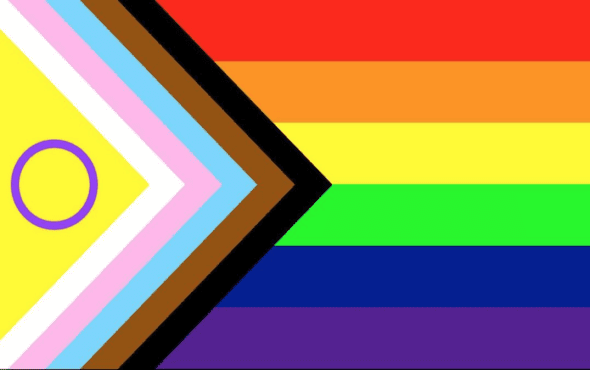Pride flag receives an even more inclusive redesign
“Please know that our intention for this flag is create intersex inclusion because we need to see it,” statement posted online reads.

To mark Pride Month, the rainbow flag has been updated to ensure inclusivity is at the heart of the LGBT+ movement.
The new design incorporates intersex people into the movement and was led by Valentino Vecchietti.
“Happy Pride 2021! For our Intersex Inclusion Campaign we’d like to share with you our new intersex-inclusive Pride Progress flag,” an Instagram post read.
“Please know that our intention for this flag is create intersex inclusion because we need to see it. ” the social media statement continued.
They acknowledged that lots of different iterations eventually led to this flag.
Intersexuality, according to Planned Parenthood, is when “a person is born with reproductive or sexual anatomy that doesn’t fit the boxes of “female” or “male”. It is natural and not considered to require medical treatment.
They think that between one and two per cent of people born in the US are believed to be intersex. It can manifest in many different ways.
Often, doctors notice as soon as a child is born. Other times, it is not discovered until later in life. Families are advised “the best thing you can do is support them and love them for who they are”.
This is not the first time the flag has been updated. After it was spearheaded by Gilbert Baker, its debut in 1978 at the San Francisco Gay Freedom Parade, the same one where Harvey Milk, venerated LGBT+ activist and politician, attended. The new flag builds upon generations of development.
The new addition is a yellow section completed with a purple circle. It was devised by Morgan Carpenter, who works at Intersex Human Rights Australia.
“This is one attempt to create something that is not derivative, but yet is firmly grounded in meaning. The colour yellow has long been regarded as an intersex color, neither blue nor pink. Purple, too, has been used for the same purpose,” the group’s website states.
This follows in the tradition of adding different perspectives to the flag, as did Amber Hikes, who introduced a revamped version that added black and brown stripes in 2017. This was to ensure that racially diverse people felt at home underneath the LGBT+ movements. At the time of its launch, she explained reasoning behinds it inception.
“It’s a push for people to start listening to people of color in our community, start hearing what they’re saying, and really to believe them and to step up and say, ‘What can I do to help eradicate these issues in our community?,” she said according to NBC News.
A year later, in 2018 Daniel Quasar added the colors of the transgender cause into the flag; blue, white and pink.
The original flag was designed Monica Helms, a transwoman, in 1999. Each color represents something, pink for femininity, blue for masculinity and white for non binary.
Pride Month takes place annually each June, and it seeks to celebrate the love, achievements and progress of all aspects of LGBT+ people. Its origins date back to the Stonewall Uprising in 1969. The first Pride March took place in New York City on the anniversary in 1970 with between 3,000 to 5,000 participants.
At the most recent Manhattan march in 2019, it was estimated that 150,000 took part, according to the BBC, and was considered to be the biggest in New York’s history. According to The Guardian, 1.5 million turned out at the last Pride parade in London.
Last year, due to the pandemic, countless Pride events across the world were cancelled.
Join our commenting forum
Join thought-provoking conversations, follow other Independent readers and see their replies
Comments
Bookmark popover
Removed from bookmarks